|
Areal view of Sunrise Beach, Forked River, Lacey Township which shows a historic development pattern that pre-dates current floodplain management and land development regulations. Wetlands on either side of this development are preserved as part of the Forsythe National Wildlife Refuge, owned by the U.S. Fish and Wildlife Service.
Welcome!
Welcome to the inaugural edition of the National Flood Insurance Program (NFIP) Floodplain Communicator, New Jersey’s first quarterly floodplain management newsletter written for local officials and funded through a compliance assistance grant from the Federal Emergency Management Agency (FEMA). It is anticipated that this newsletter will assist the 552 local governments that participate in the National Flood Insurance Program (NFIP) so they can meet the minimum standards and explore ways to improve resiliency and implement higher floodplain standards. This newsletter will also help keep local officials informed on New Jersey’s efforts to adapt as New Jersey’s climate changes.
This newsletter is produced by the New Jersey State NFIP Coordinator’s Office, under the direction of John H. Moyle, P.E. This Bureau is responsible for managing floodplain analysis and mapping responsibilities under FEMA’s Cooperative Technical Program (CTP) grant and assistance to local Floodplain Administrators under the Community Assistance Program State Support Services Element (CAP SSSE) grant. It is in the Division of Dam Safety and Flood Engineering under the Climate and Flood Resiliency Program, led by Chief Resilience Officer and Assistant Commissioner, Dave Rosenblatt.
In this edition
 The NFIP is a nationwide voluntary program providing flood insurance to property owners in participating communities. Participating in the program ensures that property owners can receive federally-backed mortgages and loans for properties in the floodplains and that participating communities can receive public assistance to cover flood-related post-disaster costs in excess of municipal insurance policies. NFIP participation is also required for receiving federal grants from FEMA for property acquisition and elevation, demolition, and relocation of structures in the floodplain. As a condition of participation, communities agree to perform floodplain management duties and comply with 44CFR Parts 59 and 60 by adopting new FIRM maps, designating a Floodplain Administrator position in a municipal flood damage prevention ordinance, issuing floodplain development permits for both structural and non-structural development, and enforcing their ordinance to keep development “reasonably safe from flooding”.
The appointment and training of a Floodplain Administrator is very important to a community’s success in reducing flood damage. Floodplain Administrators are responsible for enforcing the floodplain development ordinance, ensuring that new and substantially improved structures are properly elevated, requiring that flood damage resistant building practices are followed, as well as notifying FEMA of any changes to watercourses and assisting property owners with the Letter of Map Change process. More than any other local official, the Floodplain Administrator has the responsibility and knowledge to lead their community towards a more resilient future with a faster post-disaster recovery. In many towns that participate in FEMA’s Community Rating System, the Floodplain Administrator has encouraged higher resiliency standards and best practices while reducing flood insurance premiums in their communities.
On May 13, 2019, Cliffside Park officially became New Jersey’s 552nd NFIP community, joining 550 other municipalities and the New Jersey Sports and Exposition Authority. (The New Jersey Sports and Exposition Authority regulates zoning and floodplains in 14 towns in Bergen and Hudson Counties and participates as a community in the NFIP.) New Jersey communities that do not participate generally do not because of geographically advantaged terrain and/or floodplains that exclude municipal development.
Back to top.
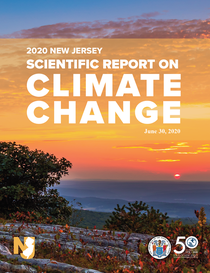
In October 2019, Governor Murphy signed Executive Order No. 89, appointing New Jersey’s first Chief Resilience Officer (Assistant Commissioner Dave Rosenblatt), establishing the Interagency Council on Climate Resilience, and ordering the development of Statewide Climate Resilience Strategy to protect and promote public health and safety, as well as the physical, economic and social vitality of New Jersey’s diverse communities. Included in this Strategy will be a standalone Coastal Resiliency Plan. Together, these plans will make recommendations to guide New Jersey’s adaptation and strategies to prepare for climate change and rising sea levels.
In January, 2020, Governor Murphy followed up with Executive Order No. 100, ordering DEP to undertake the New Jersey Protecting Against Climate Threats (NJ PACT) , initiative, which will modernize the State’s environmental regulations to implement reductions in greenhouse gas emissions, and build resilience measures into the State’s environmental land use rules. Some of these changes may affect how floodplains and buildings are regulated Statewide. As these rule changes are made, future editions of this newsletter will communicate rule changes that impact State-level permitting and local government decision-making.
On June 30th, NJDEP released New Jersey’s Scientific Report on Climate Change. This report synthesized the latest and most reliable scientific information on the current and predicted future impacts of climate change. Two key findings stood out:
- Annual precipitation is expected to increase from 7% to 11% by 2050 and occur in more intense rain events that could result in an increase in localized flooding; and
- By 2050, there is a 50% chance that sea-level rise will meet or exceed 1.4 feet and a 17% chance it will meet or exceed 2.1 feet, resulting in increased coastal flooding during sunny days and storm events, impacting infrastructure, residents and businesses. Sea level will further increase by 2100—by as much as 6 or more feet.
Together, these findings require that New Jersey take a closer look at development in the floodplain as well as in areas that may flood in the future. Already, there are more instances of sunny day nuisance flooding on the coasts and more localized heavy rainfalls like the storm that flooded parts of Burlington, Camden, and Gloucester Counties in June of 2019.
Back to top.
|
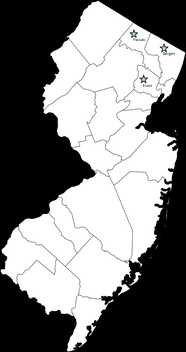
In the past year, FEMA issued Letters of Final Determination to communities in Bergen, Passaic, and Essex Counties requiring that new Flood Insurance Rate Maps (FIRM’s) be adopted in a flood damage prevention ordinance by each participating community within a 6 month period or risk suspension in the National Flood Insurance Program (NFIP). Each of these map adoptions involved the restudying of riverine watercourses using airborne LiDAR, which relies on laser light and its reflection to make a three-dimensional point cloud representation of the area below. This methodology results in a more accurate and cost-effective way to determine surface elevations, especially in highly urbanized areas.
Unfortunately, the most recent coastal study data in coastal areas of Bergen and Essex counties was not incorporated into the new maps, resulting in the FEMA Memorandums, discussed below. Throughout the adoption process, FEMA and the NJDEP held public meetings in these counties and invited both the general public and municipal Floodplain Administrators to understand, review and provide comment prior to the adoption of the maps. Now that the maps have been finalized and adopted, any requested changes to the map must go through a formal Letter of Map Change process. This process requires individuals to hire a surveyor to submit a Letter of Map Amendment or, individuals or towns to hire a professional engineer to perform a hydrologic and hydraulic analysis and request a Letter of Map Revision. More information on this process can be found here.
The following lists the changes by county and municipality.
-
Bergen County – Issuance of a County-wide Effective Map – all communities adopted ordinances by August 28, 2019 except for Alpine and Englewood Cliffs, which do not participate in the NFIP.
-
Essex County – Issuance of Effective Maps affecting the following communities:
- Belleville, Bloomfield, Caldwell, Cedar Grove, East Orange, Essex Fells, Fairfield, Glen Ridge, Livingston, Montclair, Newark, North Caldwell, Nutley, Orange, Roseland, Verona, and West Caldwell.
- These communities adopted the ordinances before April 3, 2020.
-
Passaic County – Issuance of Effective Maps affecting the following communities:
- Bloomingdale, Clifton, Haledon, Hawthorne, Little Falls, North Haledon, Passaic, Paterson, Pompton Lakes, Prospect Park, Ringwood, Totowa, Wanaque, Wayne, West Milford, and Woodland Park.
- These communities adopted the ordinances before April 17, 2020.
Back to top.
|
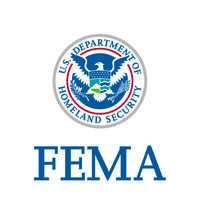
FEMA is committed to providing guidance to NFIP communities on the use of work maps, Preliminary Flood Insurance Rate Maps (FIRMs) and a Flood Insurance Study (FIS) or when Advisory Base Flood Elevations (ABFEs) are available to communities for new and substantially improved/substantially damaged structures. This October 11, 2016 policy is available on FEMA’s website here. Although this policy has been more recently updated, it was in effect after Superstorm Sandy when Advisory Base Flood Elevations (ABFEs) were released to help communities rebuild using the best available flood data and informing elevation decisions related to the Increased Cost of Compliance section of NFIP insurance policies which provide up to $30,000 for mitigating structures.
Recently, two memorandums were issued in Bergen and Essex Counties to the Division of Dam Safety and Flood Engineering that establish the best available data for the coastal zones in these counties. To better understand why this was necessary, it is important to understand the history of coastal mapping following Superstorm Sandy. In 2012, ABFE’s were issued in New Jersey’s coastal areas in accordance with FEMA’s abovementioned policies. In 2014, preliminary coastal FIRM maps replacing the ABFE’s were issued. However, New York City appealed the maps citing concerns with storm surge analysis. FEMA decided to restudy these areas while keeping the current preliminary coastal mapping in effect.
In February of 2019, FEMA released a newsletter that anticipates new effective coastal FIRM maps will be adopted in 2024. Also, in February 2019, new effective FIRM maps were issued for Bergen and Essex counties that reflected a long-planned study of riverine areas which included changing the datum from NGVD 29 to NAVD 88 for Bergen County. However, these new FIRM maps did not incorporate the recent preliminary coastal data because those maps are currently under appeal. Affected municipalities were notified during map adoption. Because it is possible that the preliminary coastal maps may not be adopted in its present form, it is important for Floodplain Administrators to regulate new and substantially improved development in coastal areas by considering the best available data provided in these preliminary FIRM maps, compare it to the effective FEMA map and chose the most stringent zone designation and elevation when issuing permits in the floodplain. The NJDEP Division of Land Resource Protection (formerly the Division of Land Use Regulation) was also notified because its regulations must consider the best available data during the permit process. The following lists the affected municipalities by county:
-
Bergen County – January 21, 2020 – Establishes the 2014 Coastal Preliminary Mapping as the best available flood hazard information. The letter outlining the use of Best Available Flood Hazard Data for Bergen County can be found here.
- Applicable to: Alpine, Carlstadt, Cresskill, Demarest, East Rutherford, Edgewater, Englewood Cliffs, Fort Lee, Hasbrouck Heights, Little Ferry, Lyndhurst, Maywood, Moonachie, New Jersey Sports and Exposition Authority, North Arlington, Norwood, Ridgefield, Rochelle Park, Rockleigh, Rutherford, Secaucus, South Hackensack, Teaneck, Tenafly, and Teterboro
-
Essex County – January 21, 2020 – Establishes the 2014 Coastal Preliminary Mapping as the best available flood hazard information. A letter outlining the use of Best Available Flood Hazard Data for Essex County can be found here.
- Applicable to: Bellville, Newark, and Nutley
Another FEMA Memorandum was issued in Union County for the Trembly Point section of Linden, which is protected by a levee. However, under the storm surge conditions predicted by the Advisory Base Flood Elevations, this “secluded area” would be impacted by floodwater overtopping the levee. The letter, referenced below, advises the Division of Dam Safety and Flood Engineering that the coastal preliminary maps are the best available data in these areas. In turn, both Linden and the NJDEP Division of Land Resource Protection were notified that this best available data must be considered during permit issuance. The following is a link to this letter.
-
Union County – September 18, 2014 – Establishes the Advisory Base Flood Elevation Maps as the best available flood hazard information. The memorandum can be found here.
- Applicable to: Linden, Trembly Point section
Back to top.
|
Every year, FEMA requires that NJDEP put together a workplan as part of the CAP SSSE grant. Over the past year, efforts have been made to formalize some foundational NFIP work products that will better align New Jersey with other FEMA efforts and initiatives nationwide. Over the next year, these work products will be introduced using a web-based meeting platforms to comply with COVID-19 social distancing requirements and we are exploring ways to make this an interactive review with Floodplain Administrators. These work products are as follows:
New Jersey Model Code Coordinated Ordinance
The Bureau of Flood Engineering is working on a New Jersey-specific version of FEMA’s Version 3 Code Coordinated Model Ordinance. This will align the flood resistant design requirements of the American Society of Civil Engineers (ASCE) 24-14 Flood Resistant Design publication referenced the New Jersey Uniform Construction Code with NFIP requirements with the Flood Hazard Area Control Act requirements. Current ordinances have gaps that do not meet the NFIP minimum requirements and the newer version will better coordinate with the Uniform Construction Code and clarify the NFIP requirements for flood resistant design for residents who don’t have access to ASCE 24-14.
Floodplain Administrator Guidebook
Building on the successful FEMA Hazard Mitigation Grant Program grant that offered free training for local officials in floodplain management and paid for them to take the Association of Flood Plain Manager’s Certified Floodplain Manager test, it was decided to invest in developing a New Jersey-specific guidebook. It is anticipated that this guidebook would serve as the backbone for defining the role of a New Jersey Floodplain Administrator now that grant funds have been expended.
New Jersey Model Floodplain Development Permit
FEMA requires that participating communities have a floodplain development permit. Recent FEMA compliance assistance visits have indicated that many permits are not actually permits but are notations, tracked on the UCC sleeve. This has raised concerns that key items required in technical bulletins are not being addressed uniformly throughout the State and that key technical information is not being provided as required by applicants during permit application. This model permit is intended to walk floodplain administrators through the permit application, issuance, variance, enforcement stages, ensuring that all required recordkeeping will be maintained.
Back to top.
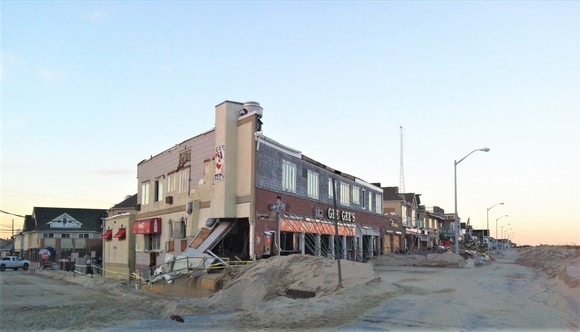
FEMA has tasked DEP with developing a substantial damage plan. Although substantial damage requirements and some best practices are covered in the Floodplain Administrator Guidebook, it is not a plan. As the saying goes, plans get completed and sit on shelves. NJDEP is looking for Floodplain Administrator and Construction Official input on best practices that can be operationalized by municipalities so that they can be dusted off and put into action post-disaster. Because FEMA has identified this issue as a priority, there is the opportunity for points in the Community Rating System and it appears that plan adoption will require the same 10-step plan adoption process used for Hazard Mitigation Plans. With several of these plans coming up on the 5-year re-adoption process, NJDEP is looking for volunteers to assist with the Model Substantial Damage Plan that can be adopted as part of the county Hazard Mitigation Plan process. If you are interested in volunteering this fall to work on this project, please contact Kenya Lovill.
Back to top.
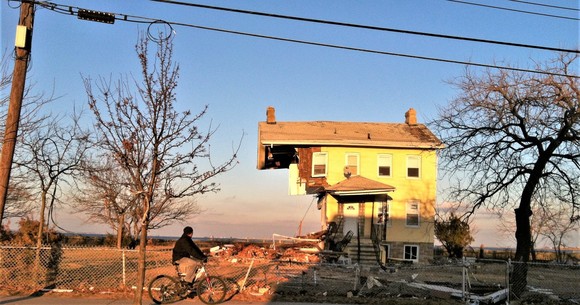
Recently, FEMA revised its process for reporting the mitigation of repetitive and severe repetitive loss properties. Tracking and mitigating severe repetitive loss (SRL) and repetitive loss (RL) properties is important for making communities more resilient. It also helps in updating National Flood Insurance Program (NFIP) data, which in turn, helps owners of mitigated properties reduce their premium costs.
FEMA designates as Severe Repetitive Loss (SRL) any NFIP-insured single family or multi-family residential building:
- That has incurred flood-related damage for which four or more separate claims payments have been made, with the amount of each claim (including building and contents payments) exceeding $5,000, and with the cumulative amount of such claims payments exceeding $20,000; or
- For which at least two separate claims payments (building payments only) have been made under such coverage, with the cumulative amount of such claims exceeding the market value of the building. In both instances, at least two of the claims must be within 10 years of each other, and claims made within 10 days of each other will be counted as one claim.
A Repetitive Loss (RL) structure is a structure where two claims over a 10 year period have totaled 25% of the value of the structure or a structure where two or more claims of $1000 have been paid over a 10 year period since 1978.
Note: In determining RL and SRL status, FEMA considers the loss history since 1978, or from the building’s construction if it was built after 1978, regardless of any changes in the ownership of the building. The term “SRL property” or “RL property” refers to either an SRL/RL building or the contents within an SRL/RL building, or both.
Addressing SRL and RL properties is an important part of floodplain management and is required for Community Rating System participation. In addition, NJOEM Hazard Mtigation Grant Program, County Hazard Mitigation Plans. and NJDEP's Blue Acres Buyout program use SRL and RL information to assess and prioritize flood mitigation activities and measure success.
Tracking and completing paperwork to remove these RL and SRL properties from the NFIP records when structures are relocated, retrofitted, elevated, and bought out and demolished is an important responsibility of the local floodplain administrator and will save time and confusion if these are done on a structure-by-structure basis as they occur.
Please note, when permitting a structure elevation or floodproofing project for an RL or SRL structure in advance of removing it from RL/SRL lists, Floodplain Administrators must ensure that the newly elevated/floodproofed structures are compliant with NFIP standards. Only when these structures are deemed compliant by FEMA can they be successfully removed from the RL/SRL lists. Also, because mixed use and multi-family structures are complex to retrofit and elevate, FEMA has issued new guidance for these structures entitled “National Flood Insurance Program Mitigation Measures for Multi-Family Buildings” (FEMA p-2037/October 2019).
AW-501 Forms to remove these properties from your RL/SRL lists can be obtained here - complete pages 9-13 for each mitigated structure. (Note: Community Rating System Communities are also responsibility for completing pages 1 - 8 as part of their recertification.)
Once forms have been completed, these should be submitted to the National Flood Insurance Program (NFIP) via the NFIP Underwriting Mailbox.
All submissions must be sent individually (1 per each property location). The submission file needs to include;
- The AW-501 form and signed transmittal
- The post-mitigation Elevation Certificate for the structure
- Photographs of the mitigated structure
- Building permits
- A statement regarding the mitigation effort that was used, (elevated, demolished, relocated, retrofitted).
- A community letter, detailing methods used if the structure has been mitigated due to a project by the public works department
If a local Floodplain Administrator is interested in obtaining a copy of their community's RL and SRL properties to begin this process or to use the list for planning purposes, a request must be made in writing on the municipality's letterhead and signed by the mayor. The municipality will be required to sign an Information Sharing Access Agreement with FEMA to protect Personally Identifiable Information associated with this list. For more information on this, please contact the Region II Insurance Representative, Marianne Luhrs.
Back to top.
Recently, FEMA announced two notices of funding opportunities for hazard mitigation grant programs. The first of the two is the Flood Mitigation Assistance (FMA) grant, which is a competitive grant program that awards funds to states, local communities, federally recognized tribes and territories for projects that reduce or eliminate the risk of repetitive flood damage. Follow these links for more information on the FMA grant and grant management, and additional resources.
Building Resilient Infrastructure and Communities (BRIC) is the second of the two programs, which provides assistance to states, local communities, federally recognized tribes and territories in hazard mitigation projects which reduce the risks faced from disasters and natural hazards. This past July, FEMA hosted a Summer Engagement Series to discuss this newly developed program. Follow these links to find more information about the program, recordings of the July information sessions, and additional resources.
For those interested in participating in either the BRIC or FMA programs, sub applications need to be submitted prior to November 30th, 2020 through the new online grant system, FEMA Grant Outcomes (GO).
Below are contacts if you have any questions regarding the FEMA Advisory:
Back to top.
The New Jersey Society of Professional Land Surveyors (NJSPLS) is offering a course for New Jersey Licensed Land Surveyors to become Certified Floodplain Surveyors. This training program is offered through the National Society of Professional Surveyors. New Jersey will join two other states in offering this certification opportunity which expands a surveyor's knowledge of this specialized aspect of the profession. To date, North Carolina and Tennessee have certified 200 and 56 surveyors, respectively. The NJDEP, FEMA, and the New Jersey State Board of Professional Engineers and Land Surveyors support this certification because it improves the accuracy of the data that property owners submit to the NFIP and private insurers to use in determining insurance premiums.
This 20 hour course was going to be offered October 19 - 21 at the Clarion Hotel in Toms River. However, due to constraints with in person meetings because of COVID19, the event has been postponed. This event has been rescheduled to June 16-18, 2021. An exam will be offered at the end of the course to gain certification. The 20 credits are approved by the New Jersey State Board of Professional Engineers and Land Surveyors for CEU credits. NJSPLS will maintain a list of members who have CFS certification on their website.
Topics covered are:
- National Flood Insurance Program (NFIP) overview, objectives and terminology
- NFIP regulations for floodplain management and mitigation (federal, state and local)
- Finding, reading and using Flood Insurance Rate Maps (FIRMS) and supporting data
- Elevation Certificates - their uses and correct completion
- Letters of Map Change (LOMC) definitions, distinctions and purposes
- LOMC applications
More information on upcoming events and registration can be found here.
Back to top.
Back to top.
|